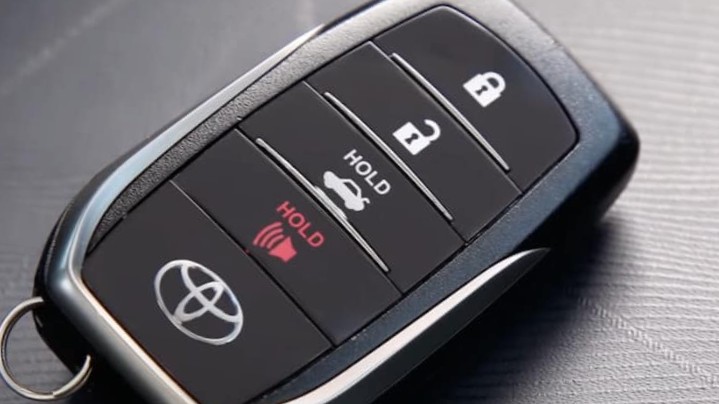Key fobs have revolutionized how we interact with our vehicles. Gone are the days of fumbling with traditional metal keys. Today, with a simple press of a button, you can unlock your doors, start your car, and even pop the trunk. This convenience is all thanks to the technology packed into your Toyota key fob, a device that uses radio frequencies to communicate with your car’s system. However, like any battery-powered device, the key fob relies on a small battery that will eventually need replacing. A dead key fob battery can be frustrating, potentially leaving you locked out of your car. Fortunately, changing the battery in your Toyota key fob is a straightforward process you can easily do yourself at home.
This guide will walk you through the simple steps to replace your Toyota key fob battery, ensuring you’re never caught off guard by a dead remote. We’ll cover everything from identifying the tools you’ll need to testing your key fob after the battery replacement.
What You’ll Need
Before you begin, gather these simple tools and supplies to make the process smooth and efficient:
- New Battery: Most Toyota key fobs use a CR2032 battery. It’s always a good idea to double-check your owner’s manual or the old battery itself to confirm the correct type. You can purchase these batteries at most drugstores, big-box retailers, and online.
- Small Flathead Screwdriver or the Emergency Key: Depending on your Toyota model and key fob design, you’ll need a small flathead screwdriver or the mechanical emergency key that’s hidden within your key fob to open the casing.
- Soft Cloth or Towel (Optional): Using a soft cloth can help prevent scratches on your key fob casing during the opening process.
Once you have these items ready, you’re all set to replace your Toyota key fob battery.
Step-by-Step Guide to Changing Your Toyota Key Fob Battery
Replacing your Toyota key fob battery is a quick and easy task. Follow these steps to get your key fob working like new again:
1. Remove the Emergency Key
The first step is to access the mechanical emergency key housed within your key fob. Locate the small release button, usually a metallic button, on your key fob. Press and hold this button to release the emergency key. Slide the key out and set it aside. This key can be used to manually unlock your car door if needed, and it will also be helpful in opening the key fob casing.
 Removing the emergency key from a Toyota key fob
Removing the emergency key from a Toyota key fob
2. Open the Key Fob Casing
Now, you need to open the key fob to get to the battery inside. The method varies slightly depending on whether you have a newer or older Toyota model.
-
Newer Toyota Models: Look for a small rectangular slot on the key fob casing. Insert the emergency key blade into this slot. Gently twist or pry the key to separate the two halves of the key fob casing.
-
Older Toyota Models: If you don’t see a slot, look for a small notch along the seam of the key fob. Use a small flathead screwdriver or the edge of the emergency key. Carefully insert the screwdriver or key into the notch and gently twist to pry the case open. Work your way around the seam if necessary until the two halves separate. Be careful not to apply excessive force, which could damage the casing. Using a soft cloth between the screwdriver and the fob can prevent scratches.
3. Access the Battery Compartment
Once the key fob is open, carefully separate the two halves. Inside, you’ll typically see a circuit board. The battery compartment is usually located underneath or beside this circuit board. In some models, you might need to gently lift or remove the circuit board to access the battery. Be extremely careful when handling the circuit board to avoid damaging any of the small electronic components. It is advisable to take a picture at this stage to remember the orientation of the battery and circuit board for reassembly.
4. Identify the Battery Type
Before removing the old battery, take note of the battery type and its orientation (the way it’s placed in the compartment). Most Toyota key fobs use a CR2032 battery. You’ll usually find the battery type printed directly on the battery itself. Confirm this is the correct battery type before proceeding. Knowing the correct battery ensures you purchase the right replacement.
5. Install the New Battery
Now, remove the old battery. You might be able to gently pry it out with your fingertip, or you can use the tip of a screwdriver to carefully nudge it out. Take the new CR2032 battery and install it in the battery compartment in the same orientation as the old one. Usually, the positive (+) side of the battery faces upwards, but refer to your photo or the markings in the battery compartment to be sure. Press down firmly to ensure the new battery is securely in place.
6. Test the Key Fob
With the new battery installed, carefully reassemble the key fob casing by snapping the two halves back together until they are firmly closed. Re-insert the emergency key back into the key fob until it clicks into place. Now, test your key fob. Try locking and unlocking your car doors using the buttons on the fob. Also, test other functions like opening the trunk or activating the panic alarm to ensure everything is working correctly. If the key fob functions as expected, you’ve successfully replaced the battery! If it doesn’t work, double-check the battery orientation and ensure the battery is correctly seated in the compartment before reassembling and testing again.
Signs Your Toyota Key Fob Battery Needs Replacing
Being aware of the signs of a low key fob battery can prevent you from being unexpectedly locked out of your Toyota. Here are some common indicators that your Toyota key fob battery is nearing the end of its life:
- Reduced Signal Range: You may notice that you need to be closer to your car than usual for the key fob to work. If you have to press the buttons multiple times or stand right next to the vehicle for it to respond, the battery is likely weakening.
- Dim or No Light on the Key Fob: Many key fobs have an indicator light that illuminates when you press a button. If this light is dim, flickering, or doesn’t light up at all, it’s often a sign of a low battery.
- Inconsistent Performance: The key fob may work intermittently, sometimes working from a distance and other times not responding at all. This erratic behavior can indicate a battery that is losing power.
- Dashboard Warning Light: Some newer Toyota models may display a warning message or key fob battery symbol on the dashboard when the key fob battery is low. Check your owner’s manual to see if your vehicle has this feature.
- Sluggish Response: If there’s a noticeable delay between pressing a button on the key fob and your car responding, it could be due to a weak battery struggling to send a strong signal.
What to Do If Your Key Fob Still Doesn’t Work
If you’ve replaced the battery and your Toyota key fob still isn’t working, there might be another issue. Here are a few things to consider:
- Check Battery Installation: Double-check that you installed the new battery correctly, with the right orientation, and that it’s securely seated in the compartment.
- Battery Type Compatibility: Ensure you used the correct battery type (CR2032 or the type specified for your key fob). Using an incorrect battery type can prevent the key fob from working.
- Key Fob Damage: Inspect the key fob for any signs of physical damage, such as cracks, water damage, or broken components. If the key fob is damaged, it may need to be replaced.
- Vehicle Issues: In rare cases, the problem might not be the key fob itself but an issue with your vehicle’s receiver.
If you’ve tried these steps and your key fob remains inoperable, it’s best to seek professional assistance. Contact your local Toyota dealership or a qualified automotive locksmith. They can diagnose the problem, reprogram your key fob if necessary, or provide a replacement key fob if needed.
Changing your Toyota key fob battery is a simple maintenance task that can save you time and prevent inconvenience. By following these steps and being aware of the signs of a low battery, you can keep your key fob working reliably for years to come.
